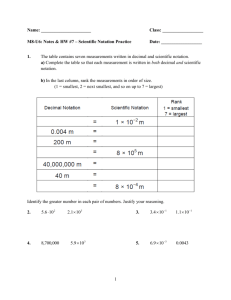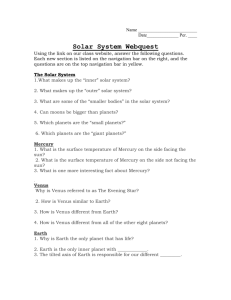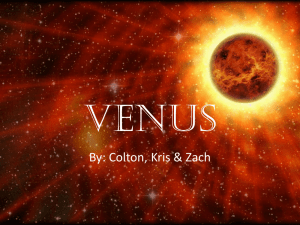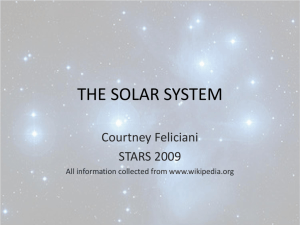TerrestrialPlanets
advertisement
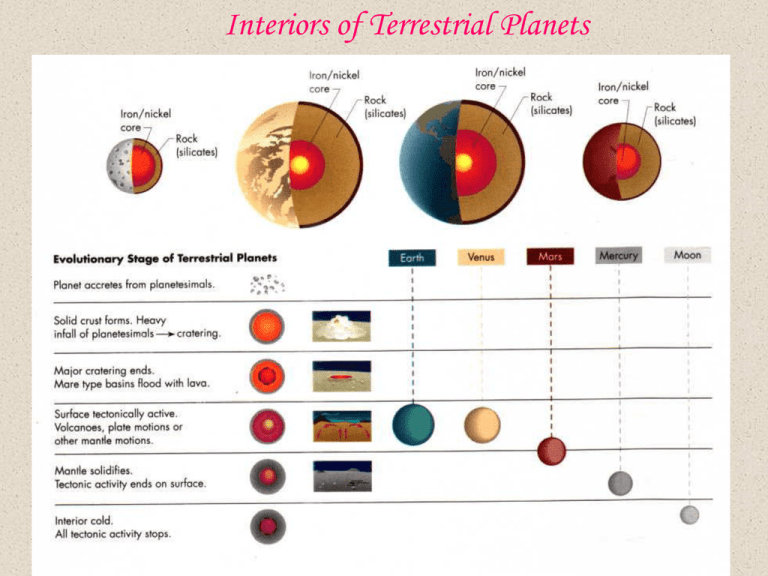
Interiors of Terrestrial Planets Mercury •MEAN RADIUS: 2439.7 km •MASS: 0.055 (Earth=1) •DENSITY: 5.43 (g/cm^3) •GRAVITY: 0.376 (Earth=1) •ORBIT PERIOD: 87.97 (Earth days) •ROTATION PERIOD: 58.65 (Earth days) •SEMIMAJOR AXIS OF ORBIT: 0.387 au •ECCENTRICITY OF ORBIT: 0.206 The Resonant Rotation of Mercury Mercury’s large core may indicate a “mantle-stripping” impact with a similar body. 1 solar day = 176 Earth days 1 sidereal day= 59 Earth days Venus •MEAN RADIUS: 6051.9 km •MASS: 0.814 (Earth=1) •DENSITY: 5.24 (g/cm^3) •GRAVITY: 0.903 (Earth=1) •ORBIT PERIOD: 224.7 (Earth days) •ROTATION PERIOD: 243.0 R (Earth days) •SEMIMAJOR AXIS OF ORBIT: 0.723 au •ECCENTRICITY OF ORBIT: 0.007 The External Appearance of Venus Venus in visible light – cloud shrouded Venus in the ultraviolet – cloud patterns rotate every 4 days. Radar Maps of Venus The Magellan probe provided a high resolution elevation map of Venus, with information on reflectivities that indicate textures. Craters on Venus Volcanoes on Venus The Real Surface of Venus Actual pictures from the ground -- the Soviet Venera series Temperature: 800 degrees, Pressure: 100 atmospheres Mars •MEAN RADIUS: 3388.0 km •MASS: 0.108 (Earth=1) •DENSITY: 3.94 (g/cm^3) •GRAVITY: 0.380 (Earth=1) •ORBIT PERIOD: 686.98 (Earth days) •ROTATION PERIOD: 1.026 (Earth days) •SEMIMAJOR AXIS OF ORBIT: 1.524 au •ECCENTRICITY OF ORBIT: 0.093 Clouds, Polar Caps, and Odd Markings Mars presents many different aspects to us. Its weather and terrain are varied and changeable. Valles Marineris Canyon The Volcanoes of Mars Martian Terrains Polar Ice fields Old cratered highlands Dune Fields Evidence of Water Flows Water cannot be a liquid on Mars’ surface now, but billions of years ago it flowed (there may even have been seas. The Surface Desert of Mars Mars looks like a desert with about the same land area as the Earth. Its pink skies, however, contain far too little pressure to allow outside living. The Martian Meteorite This rock IS from Mars. Does it contains signs of life? Stay tuned…. Martian Moons: Phobos and Deimos Mars’ moons are very small; almost certainly captured asteroids. Phobos orbits in less than a day – retrograde. The Atmospheres of the Terrestrial Planets The Greenhouse Effect 1) In equilibrium, a planet must re-radiate all the energy it absorbs. 2) Solar energy tends to be converted from visible to infrared radiation. 3) Some gases are transparent to visible radiation, but opaque to infrared radiation. 4) When radiation is blocked, you need a bigger temperature gradient to push the energy through. Evolution of Terrestrial Atmospheres All the terrestrial planets start off with a substantial atmosphere. Mars lost most of it because of low escape speed. Earth converted most of the carbon dioxide into rocks. Life produced free oxygen. Venus lost the water because it stayed vapor (and solar UV released hydrogen). Summary of the Terrestrial Planets These are the “rocky” worlds of our inner solar system. The other large solid bodies in the solar system are all moons of the outer gas giant planets. They were collected by impacts of smaller bodies, and still bear those scars and effects.



